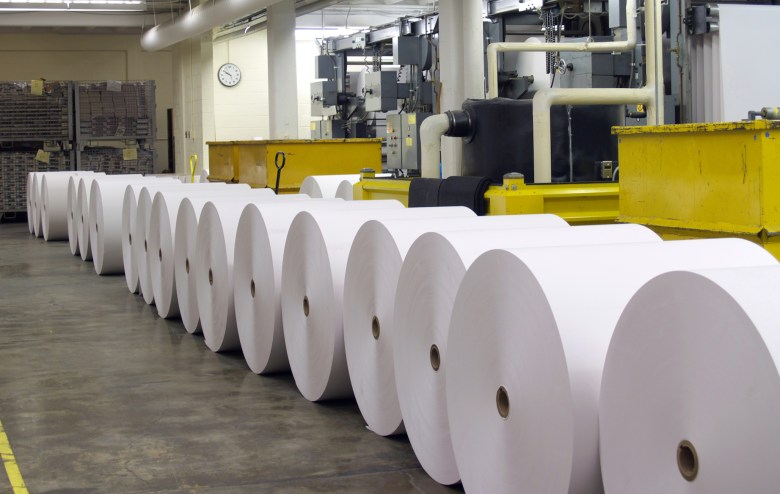
The supply of paper – particularly for newspapers, catalogues and magazines – continues to be an issue in Australia with one printer saying it will be “touch and go” for many printers to ensure they have the stock to fulfil current commitments and inventory levels required for sales growth.
Accessing paper has been an ongoing issue in Australia due to a combination of factors.
Increased gas prices in Europe have prompted a spike in pricing, while sea freight costs have increased from US$2000 to US$10,000 per container with delivery schedules also dramatically extended. A number of paper mills around the world have also converted to producing packaging board meaning less paper is being produced.
Australia now has one paper mill – Norske Skog’s operation in Boyer, Tasmania. Last year Norske Skog closed down its paper mill in Tasman, New Zealand to address capacity issues. In October 2021 the company announced additional capacity closures for 2022 and 2023, including moving to paperboard production at its mills in Bruck, Austria and Golbey, France.
Last October Norske Skog said trade statistics showed third quarter demand for newsprint in Australasia increased by one per cent, compared to the same period in 2020. It also reported “capacity utilisation was 87 per cent in the period, significantly up from 69 per cent in the previous quarter, due to the cessation of paper production at Tasman.”
In terms of the outlook, Norske Skog also reported: “The increased prices for energy, recovered paper and other input costs, coupled with significant industry closures and high operating rates resulted in publication paper price increases for all grades in Europe from 1 July 2021. However, the unprecedented cost increases are expected to continue and have necessitated further price increases in the fourth quarter of 2021 and into 2022.”
A spokesman for Norske Skog told Sprinter that publication paper has been in oversupply for many years.
“Capacity reductions globally through conversions and closure has helped reduce the oversupply, although the broader systemic decline in the demand for publication papers continues. In addition, and more recently, significant price increases for a range of inputs, particularly in Europe has necessitated those cost increases be passed on to customers in order for many manufacturers to remain viable. In Australia and New Zealand, Norske Skog has contractual obligations to supply. As we have done for many years, we continue to honour those obligations,” he said.
“Norske Skog has long standing relationships with many of the printers and will continue to support them given the available production from the Boyer Mill. Most of the printers have historically procured some of their paper requirements from overseas and Norske Skog expects they will continue to do so.
“As the Boyer Mill in Tasmania is the sole domestic producer of publication paper any downtime at the mill will potentially have an impact on paper supply. Shipping and other domestic transport disruptions can also have an impact.”
Sprinter has also contacted a number of printers for input on this story.
Spotpress managing director John Georgantzakos told Sprinter it is like a daily military operation to ensure raw materials are available, but he says the best way forward is to order through various paper suppliers and put price secondary to supply.
“It will be touch and go for most printers if they will have the paper stock to fulfil their current commitments let alone have inventory levels to cater for sales growth.
“USA and Canadian mills are overcommitted serving their local markets and at this stage are not accepting orders from Australia. A similar situation exists with some European mills.
“Most mills have placed their customers on strict allocation of paper.”
John Georgantzakos, managing director, Spotpress
Georgantzakos said he has spent six months building up Spotpress’ paper inventory levels in anticipation of this problem, but he will still feel the pressure this year.
“A great effort has been placed to de-risk the situation by ordering from every supplier still committed to the Australian market. Price is secondary versus ensuring supply,” he said.
Georgantzakos has been ordering paper through the mill in Boyer for decades but he understands this mill is under pressure due to the closure of the Tasman site in New Zealand.
“Spotpress has been consistently buying paper from the Tasmanian mill for over 40 years. However, due to the closure of Norske’s New Zealand mill, I am told that their Tasmanian mill is under enormous pressure. I understand that all their customers have had a monthly cap introduced on the quantities they may order from the Tasmanian mill. I presume this is the only way Norske Skog can ensure all the Australian market is fairly serviced,” Georgantzakos said.
“Spotpress has great long-term relationships with all major paper suppliers servicing the Australian market. These suppliers are working around the clock to ensure supply to the Australian market. I know that it is extremely challenging for them.”
Ovato CEO James Hannan said after nine months of delays, Ovato has a solid and stable platform of forward paper orders, but adds the ongoing delays to freight certainly do make some weeks challenging.
“We certainly are not carrying the safety stock that we would like, but we have not yet let any clients down, in fact we have been in the fortunate position of being able to help many who have required it. Our long-standing relationships with major suppliers (as opposed to shopping around on the spot market, which is currently non-existent) has enabled us to secure allocation locally and internationally, albeit with extended lead times. It is all about supply now, price is secondary if you can’t get the paper in the first place,” Hannan told Sprinter.
Pricing is also an issue with Hannan reporting Ovato is facing increases between 15 and 35 per cent, depending on the grade, with further increases expected throughout the 2022 calendar year.
“We are also hearing about freight levy’s being introduced so that will also impact manufacturing pricing. The forecast stabilisation in 2022 we were all hoping for seems to be weakening by the week and looking more likely to be well,” he said.
Ovato’s executive general manager – sales, Clinton Willis, said customers have been understanding of the pressures.
“Customers have been very understanding as the macro-economic pressures causing the increases are well known – Freight issues, energy issues in Europe, COVID etc. That being said, many clients have fixed budgets, so something needs to give, and it will often be format change, gsm change, pagination drop or quantity,” Willis said.
Kellie Northwood, CEO of The Real Media Collective and executive director of the Australasian Paper Industry Association, said it is important to split paper grades into two buying categories to better understand this problem – Publisher/Retailer and Commercial Print.
“For Publishers and Retailers, newsprint and catalogue (LWC) ranges, there is a significant shortage globally,” Northwood told Sprinter.
“Predominantly Australia and New Zealand source these papers from a single local mill in Norske Skog Boyer and the remaining from Europe. Locally, Norske Skog is honouring its Australian and New Zealand publisher commitments, however this is a small volume and the European mills are struggling to supply the remaining volumes for many reasons – freight is being delayed with containers being held in overseas ports, once on our shores there are port and quarantining issues which we are consulting the Department of Agriculture about directly.
“Additionally, European mills, particularly those producing newsprint product, are facing local industrial disputes and experiencing worker shortages due to COVID illness. All of these matters collectively trickle down to impact supply within Australia and New Zealand.”
Northwood added: “We have reviewed European and North American supply and all are on allocation for their local and regional supply chains. Current lead times for publisher and retailer grades are experiencing 6-7 months and this could widen in the coming weeks, which is why we are working with publishers and retailers to advise of pre-scheduling further in advance than ever before to ensure we can maintain the supply as seamlessly as possible despite these challenging times.

“In regards to Commercial Print or marketing print grades, the merchants do have a greater depth of inventory and, whilst Japanese and Chinese mills are in tight supply as they are converting to packaging lines, the Korean mills have some scope which is providing some loosening of lead times. Our local merchants are well equipped to mitigate this for our commercial printers, however we will as an industry need to monitor this and understand, like many other industries, we are experiencing supply chain shortages from workers unable to produce, dispatch, freight and distribute products – paper, grocery supplies and more included.”
Pricing on the rise
Prices are also dramatically on the rise with Georgantzakos reporting locally produced newsprint has risen 45 per cent with overseas made newsprint up by over 100 per cent. Coated stocks (LWC and MWC) have risen between 40 per cent and 80 per cent, he said.
“All our customers have understood the existential threat our industry (and theirs) is facing from this problem. They have accepted significant price increases to their print contracts despite the financial strain they have endured during the past two years. It is very difficult for them,” Georgantzakos said.
“Our greatest fear is that these paper price increases will force their hand to switch to a digital only publishing model.”
This week News Corp also published an article on newsprint supply issues, reporting that some magazine publishers have just one week’s supply readily accessible instead of the usual one month or more in reserve.
Ball & Doggett national marketing manager, Tony Bertrand, has also put together a useful blog on the drivers of supply issues – you can read it here. Last year Sprinter also put together this piece on sea freight surging costs and how this is effecting suppliers.
Bertrand also suggests printers investigate Ball & Doggett’s i_CONSIGNMENT inventory management system to help ensure all supply needs are met.
Comment below to have your say on this story.
If you have a news story or tip-off, get in touch at editorial@sprinter.com.au.
Sign up to the Sprinter newsletter
